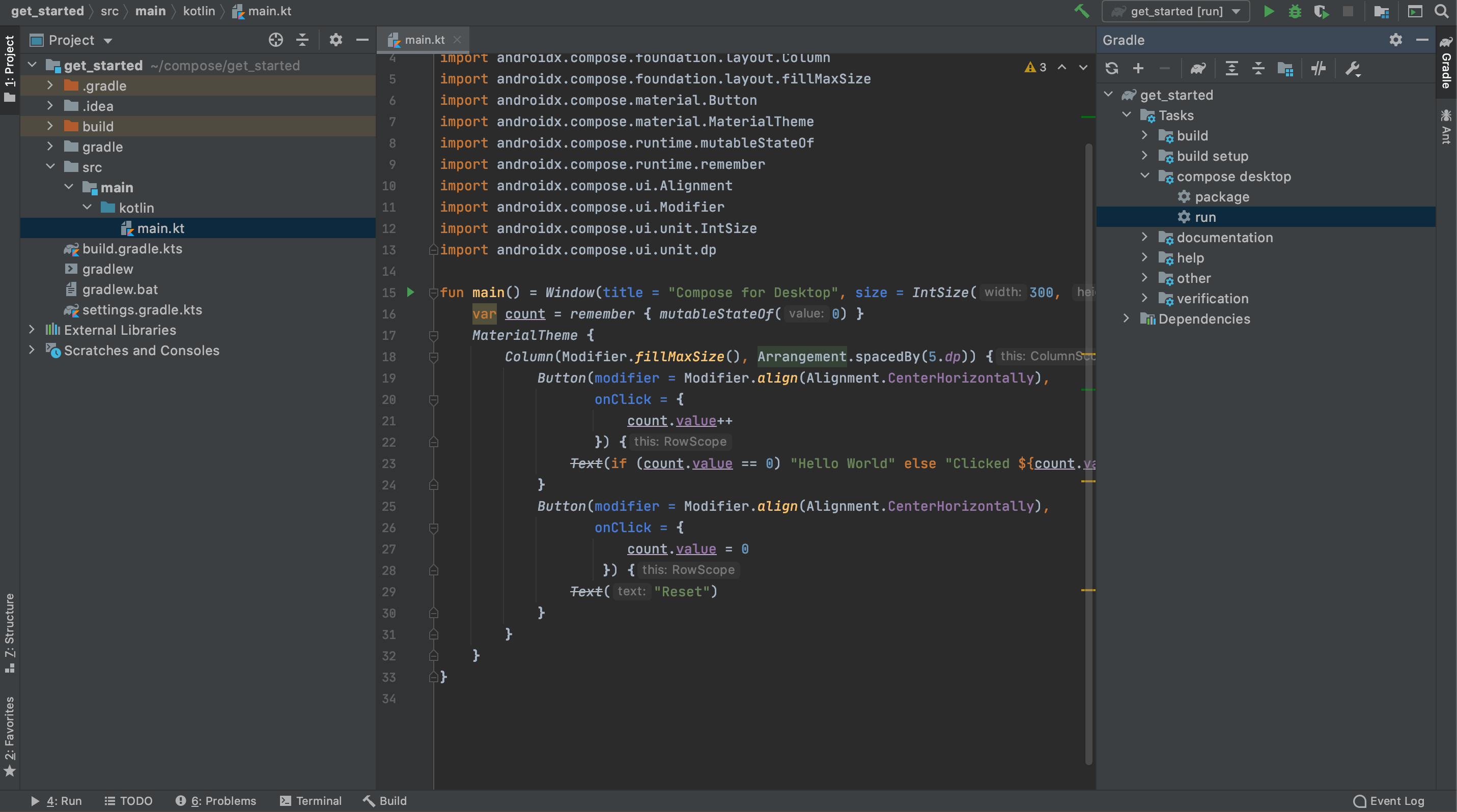|
|
4 years ago | |
|---|---|---|
| .. | ||
| README.md | 4 years ago | |
| screen1.png | ||
| screen2.gif | ||
| screen3.png | ||
| screen4.png | ||
| screen5.png | ||
README.md
Getting Started with Compose for Desktop
What is covered
In this tutorial we will create a simple desktop UI application using the Compose UI framework.
Prerequisites
Compose for Desktop can produce applications for macOS, Linux and Windows platforms, and so any of these platforms can be used for this tutorial.
The following software has to be preinstalled:
- JDK 11 or later
- IntelliJ IDEA Community Edition or Ultimate Edition 20.2 or later (other editors could be used, but we assume you are using IntelliJ IDEA in this tutorial)
Creating a new project
New project wizard
Kotlin support in IDEA IDE starting with the version 2020.3 comes with the new project wizard capable to create a Compose application automatically.
Note that JDK must be at least JDK 11, and to use the native distribution packaging JDK 15 or later must be used.
Update the wizard plugin
The Сompose plugin version used in the wizard above may be not the last. Update the version of the plugin to the latest available by editing the build.gradle.kts file, finding and updating the version information as shown below. In this example the latest version of the plugin was 0.5.0-build225 and a compatible version of kotlin was 1.5.10. For the latest versions, see the latest versions site and the Kotlin site.
plugins {
kotlin("jvm") version "1.5.10"
id("org.jetbrains.compose") version "0.5.0-build225"
}
Create new Compose project without the wizard
It is also possible to create Compose project manually.
The recommended way of building Compose for Desktop projects is by using Gradle. JetBrains provides a simple way of building Compose for Desktop projects using a special Gradle plugin.
One could clone an existing template for a desktop or multiplatform application, or create it from scratch.
First create a new directory, named sample.
mkdir sample
cd sample
Create settings.gradle.kts as follows:
pluginManagement {
repositories {
gradlePluginPortal()
maven("https://maven.pkg.jetbrains.space/public/p/compose/dev")
}
}
Then create build.gradle.kts with the following content:
import org.jetbrains.compose.compose
plugins {
kotlin("jvm") version "1.5.10"
id("org.jetbrains.compose") version "0.5.0-build225"
}
repositories {
mavenCentral()
maven("https://maven.pkg.jetbrains.space/public/p/compose/dev")
}
dependencies {
implementation(compose.desktop.currentOs)
}
compose.desktop {
application {
mainClass = "MainKt"
}
}
Then create src/main/kotlin/main.kt and put the following code in there:
import androidx.compose.desktop.Window
import androidx.compose.foundation.layout.Arrangement
import androidx.compose.foundation.layout.Column
import androidx.compose.foundation.layout.fillMaxSize
import androidx.compose.material.Button
import androidx.compose.material.MaterialTheme
import androidx.compose.material.Text
import androidx.compose.runtime.mutableStateOf
import androidx.compose.runtime.remember
import androidx.compose.ui.Alignment
import androidx.compose.ui.Modifier
import androidx.compose.ui.unit.IntSize
import androidx.compose.ui.unit.dp
fun main() = Window(title = "Compose for Desktop", size = IntSize(300, 300)) {
val count = remember { mutableStateOf(0) }
MaterialTheme {
Column(Modifier.fillMaxSize(), Arrangement.spacedBy(5.dp)) {
Button(modifier = Modifier.align(Alignment.CenterHorizontally),
onClick = {
count.value++
}) {
Text(if (count.value == 0) "Hello World" else "Clicked ${count.value}!")
}
Button(modifier = Modifier.align(Alignment.CenterHorizontally),
onClick = {
count.value = 0
}) {
Text("Reset")
}
}
}
}
Running the project
Open build.gradle.kts as a project in IntelliJ IDEA.
After you download the Compose for Desktop dependencies from the Maven repositories your new project is ready
to go. Open the Gradle toolbar on the right, and select sample/Tasks/compose desktop/run.
The first run may take some time, but afterwards the following dialog will be shown:
You can click on the button several times and see that the application reacts and updates the UI.




